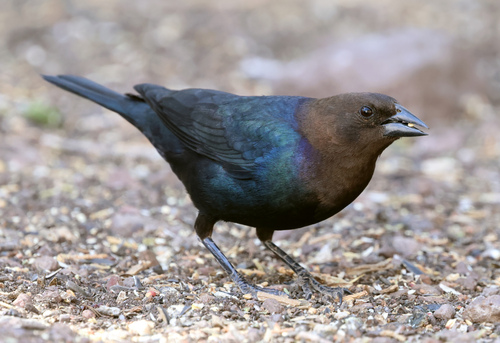
Brown-headed Cowbird
The Brown-headed Cowbird (Molothrus ater) is a small blackbird native to North America, known for its unique brood parasitic behavior. Unlike most birds, cowbirds do not build their own nests or raise their young. Instead, they lay their eggs in the nests of other bird species, leaving the unsuspecting hosts to incubate and care for the cowbird chicks. This behavior has significant ecological implications, often impacting the reproductive success of host species. Culturally, the cowbird is sometimes viewed negatively due to its parasitic habits, but it plays a complex role in its ecosystem.
16-22 cm
Length
30-36 cm
Wingspan
Least Concern
Conservation Status
Distribution
The Brown-headed Cowbird is found throughout North America, ranging from southern Canada to Mexico. It is a migratory species, with northern populations moving south for the winter. They can be found in various habitats, with a preference for edge habitats and open areas.
Lifespan
The average lifespan in the wild is about 2-3 years, though some individuals can live longer.
Brown-headed Cowbird's Habitat
Habitat Types
Grasslands, Agricultural fields, Forest edges, Open woodlands, Suburban areas
Climate Zones
Temperate, Subtropical
Adaptations
Cowbirds have adapted to a wide range of habitats, demonstrating flexibility in their foraging and breeding strategies. Their ability to utilize various host species for raising their young allows them to thrive in diverse environments.
Variations
There are three recognized subspecies of the Brown-headed Cowbird, distinguished primarily by subtle differences in size and coloration. These variations are often associated with geographic location.
Appearance
Breeding Plumage
During the breeding season, males have a glossy black body with a brown head. Females are a dull gray-brown overall. Non-breeding plumage is similar, but slightly duller.
Seasonal Feather Changes
There is minimal seasonal variation beyond the slightly duller non-breeding plumage.
Sex Based Plumage Differences
Yes, males and females have distinct plumage differences, as described above.
Notable Features
Short, conical bill, Dark eyes, Sturdy legs
Diet and Feeding
Primary Foods
Seeds, Insects, Grains
Foraging Behavior
Cowbirds often forage on the ground, walking or running to pick up seeds and insects. They are also known to follow grazing animals, catching insects disturbed by their movement.
Specializations
Their strong, conical bill is well-suited for cracking seeds, but they are also adept at catching insects.
Seasonal Diet Variations
Their diet shifts with the seasons. Insects are more prevalent in the diet during the breeding season, while seeds and grains dominate in the winter.
Behavior
Social Structure
Cowbirds are often found in flocks, especially outside of the breeding season. During breeding, they may be seen in pairs or small groups.
Communication
Gurgling songs by males during courtship, Chattering calls, High-pitched flight calls
Migration
Northern populations are migratory, flying south to warmer regions for the winter. Southern populations may be resident year-round.
Territorial or Group Behaviors
While not strictly territorial, males may defend areas around females during the breeding season. They often form foraging flocks outside of the breeding season.
Conservation
Threats
Habitat loss, Pesticide use
Protection Programs
None specifically for cowbirds, as they are considered a common species.
Local National Laws
Protected under the Migratory Bird Treaty Act in the United States.
Population Trend
Stable
Population Estimates
The global population is estimated to be around 56 million individuals.
Interesting Facts
Cowbirds are North America's most common obligate brood parasite.
This means they exclusively rely on other species to raise their young.
Female cowbirds can lay eggs in the nests of over 220 different bird species.
This wide range of hosts contributes to their success.
Cowbird chicks often hatch earlier and grow faster than host chicks.
This gives them a competitive advantage, often resulting in the detriment of the host's offspring.
Faqs about Brown-headed Cowbird
Why do cowbirds lay their eggs in other birds' nests?
This behavior, known as brood parasitism, allows cowbirds to reproduce without expending energy on nest building and parental care.
Do host birds ever reject cowbird eggs?
Some host species have evolved the ability to recognize and reject cowbird eggs, but many others accept them.
Are cowbirds bad for other bird populations?
Cowbird parasitism can negatively impact the reproductive success of some host species, particularly those with small populations or specialized nesting requirements.
Are brown-headed cowbirds protected?
Yes. Brown-headed cowbirds, like other migratory birds, are protected under the Migratory Bird Treaty Act.
Copyright @ Nature Style Limited. All Rights Reserved.
 English
English